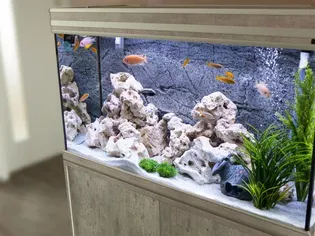How to Stock an Aquarium With Different Levels of Fish
Updated on 04/26/24

Headline: Master the Art of Aquarium Stocking: A Comprehensive Guide to Populating Different Levels of Your Tank
Introduction:
Embark on an aquatic adventure as we delve into the intricacies of stocking an aquarium with fish of various levels. From surface-skimming tetras to bottom-dwelling catfish, each species occupies a unique niche within the underwater ecosystem. By understanding their specific habitat preferences, we can create a harmonious and thriving environment for our finned friends.
Chapter 1: Surface Dwellers - Aerial Acrobats
Surface-dwelling fish are the spirited acrobats of the aquarium, darting along the water's surface with effortless grace. These agile creatures include:
* Neon Tetras: With their vibrant blue and red stripes, neon tetras are a captivating sight. They prefer a well-planted environment with ample swimming space.
* Guppies: Known for their colorful and varied finnage, guppies are prolific breeders. Provide them with plenty of vegetation for cover and to prevent overpopulation.
* Danios: The torpedo-shaped danios are known for their rapid and playful behavior. They thrive in groups and require a moderately fast current.
Chapter 2: Mid-Level Swimmers - Curious Explorers
Mid-level swimmers inhabit the heart of the aquarium, exploring the depths while maintaining a connection to the surface. Examples include:
* Angel Fish: Majestic and graceful, angel fish are true showstoppers. They prefer a well-planted tank with plenty of vertical space for swimming.
* Swordtails: These colorful fish are named for their elongated, sword-like tail fins. They are relatively easy to care for and make excellent community members.
* Mollies: Hardy and adaptable, mollies come in a wide range of colors and patterns. They appreciate a tank with a mix of vegetation and open swimming areas.
Chapter 3: Bottom Dwellers - Mysterious Guardians
Bottom dwellers patrol the base of the aquarium, ensuring its cleanliness and providing a sense of security. Notable species include:
* Catfish: The whiskered catfish are essential algae eaters, helping to keep the tank clean. They prefer a sandy substrate and plenty of hiding places.
* Corydoras: These armored catfish are peaceful and social creatures. They scavenge for food at the bottom and require a fine substrate to prevent injuries.
* Loaches: Loaches add a touch of intrigue to the aquarium with their eel-like appearance and nocturnal habits. They enjoy burrowing and require a substrate that supports their digging behavior.
Chapter 4: Mixed Level Communities - Harmony in Diversity
Creating a mixed-level aquarium allows us to showcase the beauty of multiple species and create a dynamic underwater ecosystem. Here are some tips for achieving harmony:
* Consider Water Parameters: Different species have varying pH and temperature requirements. Ensure the tank parameters are suitable for all inhabitants.
* Provide Adequate Space: Overcrowding can lead to stress and health issues. Research the size and compatibility of the fish you choose to ensure they have sufficient room to move.
* Create Zones: Design the aquarium with distinct zones for different levels of fish, providing each species with their preferred habitat.
* Offer Hiding Places: All fish need a sense of security. Provide ample hiding places throughout the tank, such as plants, driftwood, and caves.
Chapter 5: Plant Selection - Enhancing Natural Balance
Plants play a crucial role in a well-stocked aquarium. They provide shelter, improve water quality, and add aesthetic appeal. Consider the following:
* Floating Plants: Duckweed and water lettuce offer shade for surface dwellers and remove excess nutrients from the water.
* Mid-Level Plants: Java fern and Amazon sword create a lush environment for mid-level swimmers, providing cover and reducing stress.
* Background Plants: Tall plants like Vallisneria and Hygrophila create a secure backdrop for bottom dwellers and add vertical interest to the tank.
Chapter 6: Feeding and Maintenance - Nurturing Your Aquatic Haven
Proper feeding and maintenance are essential for the well-being of your fish. Here's how to keep your aquarium thriving:
* Feed Regularly: Determine the appropriate diet and feeding schedule for each species. Avoid overfeeding, as excess food can pollute the water.
* Perform Regular Water Changes: Replace a portion of the tank water regularly to maintain water quality and remove waste.
* Clean the Substrate: Vacuum the substrate to remove debris and prevent the buildup of harmful bacteria.
* Monitor Water Parameters: Use test kits to regularly check pH, ammonia, nitrite, and nitrate levels to ensure they are within acceptable ranges.
Chapter 7: Troubleshooting - Resolving Common Issues
Even in carefully stocked and maintained aquariums, problems can arise. Here's how to address common issues:
* Aggressive Behavior: Identify the aggressor and consider isolating it or providing more hiding places.
* Disease: Observe fish for signs of disease and treat promptly with appropriate medications.
* Algae Growth: Control algae by reducing light exposure, performing regular water changes, and adding algae-eating creatures.
* Water Quality Problems: Address water quality issues by performing water changes, checking filter efficiency, and using water conditioners.
Conclusion:
Stocking an aquarium with different levels of fish is an art form that requires careful planning and a deep understanding of the species involved. By following the guidelines presented in this comprehensive guide, you can create a thriving and harmonious underwater ecosystem that captivates the senses and brings joy for years to come. Remember, the key is to provide a balanced and healthy environment where all the inhabitants can flourish.
Explore More Pets

Freshwater Aquarium Filters
How to Deal With Cloudy Aquarium Water

Saltwater Aquarium Filters
How Do You Remove Chloramines From Tap Water?

Freshwater Aquariums & Habitat
Can I Keep My Koi Fish Inside?

Saltwater Aquariums & Habitat
14 Best Floating Plants for Your Aquarium

Freshwater Fish Health
How to Treat Ich on Freshwater Fish

Saltwater Fish Health
Fin Rot in Aquarium Fish

Freshwater Aquarium Filters
How to Do Aquarium Water Changes

Saltwater Fish Health
How Do Fish Get Parasites?